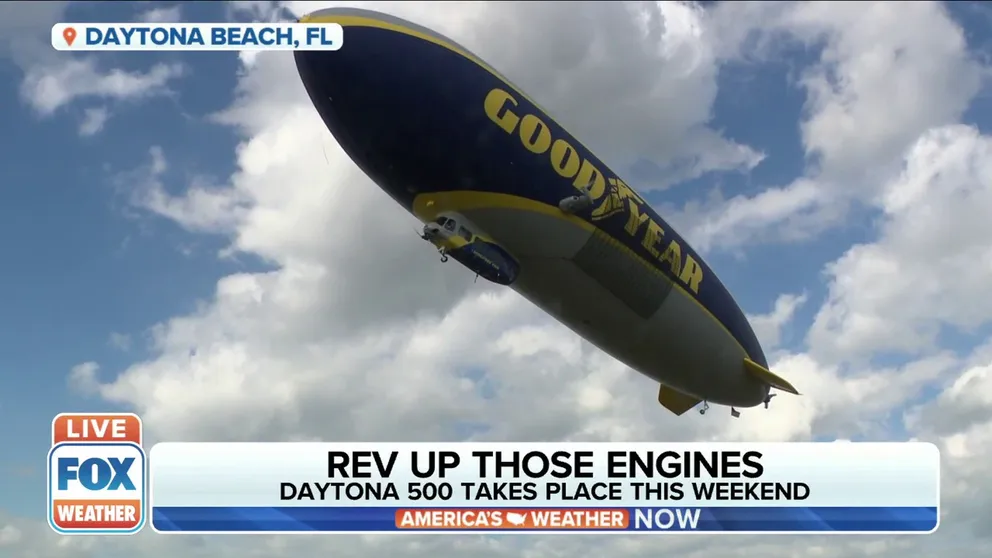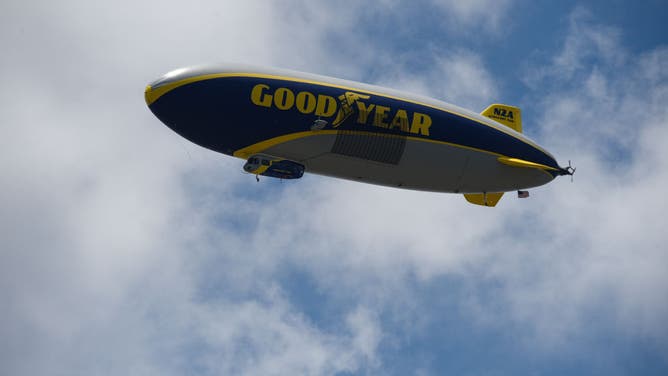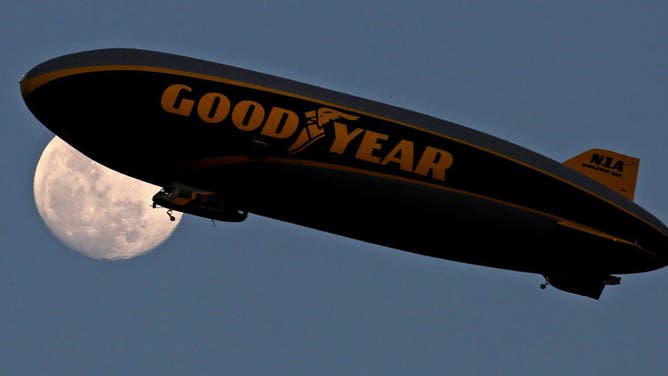Lighter than air: Piloting the Goodyear Blimp
There are fewer blimp pilots in the world than astronauts
An up-close look at the Goodyear Blimp
FOX Weather Katie Garner gives a tour of the Goodyear Blimp that will circle the Daytona 500.
DAYTONA BEACH, Fla. – This weekend, as NASCAR's best drivers compete in the Daytona 500, zooming around at 200 mph, high above the track will be a Goodyear Blimp moving closer to the pace of cars on the highway.
In the world, there are about 10 operational blimps; Goodyear operates four of those airships. Blimps are a rare sight, which means flying one is even rarer. Being able to ride in one is also a unique opportunity as they can only carry about nine people at a time, and those spots are invitation-only.
Chief pilot and operations manager for Goodyear’s Airship Operations Group Michael Dougherty said that if given a chance, it's a unique experience you'll want to check off your bucket list.
"It's kind of like riding in a bubble, the huge windows, great views," Dougherty said. "You're relatively close to the ground. We only travel at about 35 or 40 miles an hour when we're carrying passengers, so you don't miss anything going by. We have a couple of open windows that are air conditioners."
WHY YOU’LL SEE MORE DANCING IN THE RAIN THAN DRIVING AT THE DAYTONA 500
There are fewer blimp pilots worldwide than astronauts, making it a tiny club.
Fully staffed, there are 13 Goodyear blimp pilots, including Dougherty. There are about six to eight active blimp pilots nationwide, and Dougherty estimates 25 or more rated to pilot blimps.
Any pilots looking to join this small exclusive club can apply for the gig now because Goodyear is hiring a few new pilots.
Now hiring: Goodyear blimp pilots

View of the Goodyear Blimp is seen at its airship base in Carson on March 02, 2021 in Los Angeles, California. (Photo by RB/Bauer-Griffin/GC Images)
(Getty Images)
What does it take to pilot one of Goodyear’s blimps? The first qualification is the ability to fly something else.
"So airplanes or helicopters or something, and you need to know how to be a pilot, how to talk on the radio. You know, things like that," Dougherty said. "And then we refine even a few of those skills."
The certification to fly a blimp is called lighter-than-air, or LTA, because the airship can actually become lighter than air.
"You take off, and then you fly to where it's sunny, and you started where it was cloudy, and the helium heats up … and the helium is actually greater than the fuel that you're burning on the way," he explains. "So you could land on the other side heavier than you took off or lighter, lighter than air, depending on what your situation was."
Dougherty said this means he has a constant math equation going on in his head to determine the airship's weight.
"The helium does most of our lifting, so our aircraft weighs about 19,500 pounds, but when you take off in a normal configuration for our aircraft, the maximum allowable takeoff weight is just under 900 pounds. So over 19,000 pounds of our aircraft is being lifted by helium and not by a wing or a rotor or something that would normally be lifting a heavier-than aircraft like an airplane or a helicopter."
NASCAR USES SPECIALTY TRACK-DRYING TECHNOLOGY TO RID THE RAIN FROM RACETRACKS
Once you get hired on at Goodyear, the training begins. It's broken up into three phases.
The first is getting to know the airship.
"How to start it up and get it running and get it ready to go and then send it back down and be secure for the day because it's a lot of differences between airships and airplanes or helicopters," Dougherty said.
When you get to pilot the blimp for the first time, Dougherty describes it as similar to driving a boat.
"If somebody is familiar with the boat on the water where it will wander around with the currents, then it becomes a little bit difficult when you get into a docking scenario," he said. "That's a lot like what the airship is like to fly because we're trying to dock a sailboat with the sails at full mast."
Then you move on to routine flight procedures, learning how to handle an emergency or any abnormal situations. After putting it all together, the new pilot will receive their LTA rating from the Federal Aviation Administration.
Like driving a boat in the sky
Airships are very weather-dependent. A perfect day for flying would include winds between 7 and 10 mph – "nice and steady," Dougherty said.
On a more extended flight, blimps travel a distance of about 350 to 400 nautical miles and move at 45 knots, which would be about 55 mph in a straight line. Monitoring the forecast over the flight path for 8 to 10 hours is a long day for blimp pilots.
For regular pilots who are used to visual flight rules (VFR), not all those rules apply to blimps.
"It’s not like an airplane where you look at the weather kind of to see what you're going to fly through. You're really looking at the weather to see if you can fly that day if that's the right thing to do, and then we go from there."
HOLD ON, RAIN FANS! ONCE DAYTONA’S RAINY SEASON STARTS, IT’S HARD TO STOP
The best mitigation for ice or snow is to keep the airship in a hangar instead of the deicing techniques used on commercial aircraft. Freezing rain could make an airship too heavy to fly, and in that case, if it's in the air, you'll be landing whether you want to or not.
Landing and takeoff also present unique challenges.
"We can't land into a crosswind. We don't have the wings to be able to correct for it. So we always have to land directly into the wind. So our field has to be basically a round, clear area. And with our aircraft, we can actually take off and land in a relatively small space because we can take off and land vertically in the new ones, so we can take off and land kind of like a helicopter."
Blimps also do something else standard aircraft try to avoid. They fly in the clouds without being able to see. This happens by using instruments, talking to air traffic control and closely monitoring the weather.
Dougherty said the Goodyear Airship team always looks forward to race week at the Daytona 500. The airship will fly up to Daytona from Pompano Beach this weekend to be there on race day.
"We hope to have those beautiful, sunny days over the track and watch the race come to life at the Daytona 500," Dougherty said.





